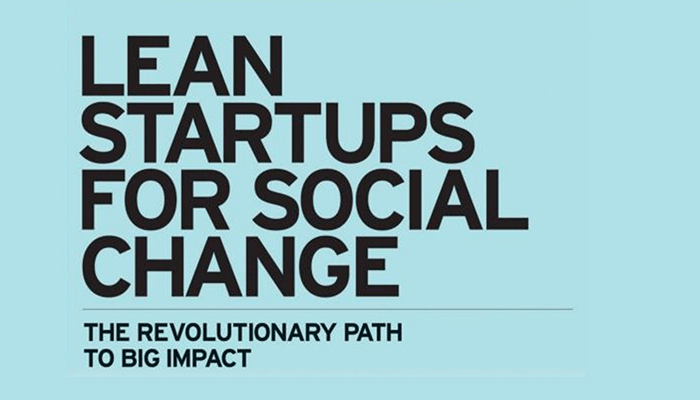The Why and the How
I knew this was going to be the foundation: designing programs and products together with beneficiaries. The Lean Startup Cycle relies on integrating potential customers in every step of the development – from the first idea to the prototype.
So, get comfortable talking to the beneficiaries you are hoping to help. ALL. THE. TIME. Let’s take a look at the Lean Startup principles, before diving into a step-by-step approach.
-
- Customer Discovery
- Value proposition
- Minimum Viable Product (MVP) & Experiments
Lean Principles
If you have laid out your entrepreneurial ideas in elaborate plans, I ask you to leave those at the door.
The Lean Startup favors experimentation over elaborate planning. Wrap your head around the fact that what you think is important or a logical solution doesn’t matter. Be humble.
In the Lean Startup world, the only way to find a solution to the problem you want to tackle is customer feedback. Don’t be a hero-preneur, be someone who listens and facilitates the solution-finding process. This translates into the development of what we call the Minimum Viable Product (MVP).
Start with a basic model of what your proposed solution looks like – bring out your inner MacGyver. Ask customers for feedback instead of designing a product or service up-front. Only to unveil it after weeks in the lab and realize that you went off in the wrong direction.
Work on it step by step, continuously soliciting feedback from your beneficiaries – they are the only ones who can help you tweak and adapt it to their needs.
There has been some pushback on the Lean Principles, particularly from professionals in the non-profit world. This build-test-respond way of thinking may be neither novel nor revolutionary to some.
If nothing else, treat it as a reminder; a way of thinking that puts you in the right mindset to solve challenges as a social entrepreneur.
The Lean Startup Process

1. Talk to beneficiaries and listen! – Customer Interviews
The first piece of advice I want to give you is to get an intimate understanding of your beneficiary’s daily lives, their needs and concerns, their dreams and desires, and their role in the community. Isolate a segment that you can clearly set apart from the wider group of beneficiaries.
Create a persona that represents this segment, including specific demographic data and information about how your “typical” beneficiary is affected by the issue. Understand what negative effects, or “pains”, the problem creates in your beneficiary’s life and find out what they find desirable in a solution.
Do they want to be happier? Healthier? Live a more dignified life? Be better off financially? In short, what are their pains and what would they like to gain from your solution?
My Second Piece of Advice:
Get out of the building! The only source to validate or believe your assumptions is your beneficiaries. Were your assumptions about them and their situation correct? Does the problem affect them the way you anticipated? Talk to A LOT of beneficiaries, be open-minded, and listen. Leave your assumptions about how they should react at home. This can be harsh, but it serves your venture in the long run.
Sometimes it’s hard to talk to beneficiaries directly. Find out who else is an expert in this area. What can you learn from others, even competitors? Cast your net wide and speak with relevant stakeholders beyond your beneficiaries: community workers, employers, government representatives, non-profits, and the like. This will save you from reinventing the wheel or walking down a dead end that others have walked before you. Learn from their experiences.
Correspond to Customers’ Needs and Desires
Throughout this discovery process, build hypotheses about your solution and how it will correspond to customers’ needs and desires. To them, what is the single most important feature of your product or service?
How much will they be willing to pay? What is the impact your product will create? When and how often will customers use it? Would they recommend it to their family and friends? Test these hypotheses when talking to beneficiaries. Check out MaRS’ guide to Customer Discovery.
2. Your Solution – Value Proposition
Having gained an in-depth understanding of the problem and its effects on your beneficiary’s lives, you have a pretty good idea of what your solution might look like. Might. That’s right. You are still not building anything other than a concept or idea of a solution. This is called your Value Proposition.
It describes what kind of value you are creating for the beneficiaries you want to work with. More specifically, it outlines how your product or service solves your beneficiaries’ problems by eliminating their pain points and creating the effects they desire in a solution. Check out Strategyzer’s video about developing a value proposition!
3. Build, test, respond – Minimum Viable Product & Experiments
Let’s assume you have developed your value proposition and presented it to your possible beneficiaries. Let’s further assume you received a lot of feedback from them and other stakeholders. Lastly, let’s assume you have taken that feedback to heart and adapted your proposed solution to meet these requirements. So far, it’s been a lot of research, talking, and more listening. At this point, you finally get to build something.
It is time to build a very basic version of your product or service:
your MVP. Bells and whistles are strictly forbidden (unless your product is a revolutionary bell or whistle). The purpose of an MVP is to sketch out what your proposed solution may look like in real life. Whether it’s an after-school program or a medical device for the homeless doesn’t matter.
Challenge yourself to create a model that emphasizes what value your solution brings to the table, and how it addresses beneficiaries’ pains and responds to their desires.
Inform Your Strategy
Instead of just collecting feedback in a conversation as you did during Customer Discovery, design experiments based on your hypotheses. Experiments allow you to test different aspects of your solution and inform your strategy going forward.
For example, if 60% of your interviewees confirm that they would use the product, does that mean you move forward, or do you need 90% confirmation? Most of us have fallen into the trap of using vanity metrics – data points that sound impressive (e.g., website clicks) but do not provide any actual insights.
Choose metrics that prove what works and what doesn’t to inform your strategy going forward. I can’t say this enough: be strict with yourself. For more information, take a look at Move The Needle’s Guide to Experiments.
Pivot or Persevere
So what have you learned? How confident are customers will buy and use your product or service? If the answer is “not many” don’t be discouraged! You know a ton more about the issue and beneficiaries than you did before. This is a pivot. Go back to the drawing board. Develop a new idea, go through the cycle, and keep at it.
If your experiments have confirmed that you are indeed on the right track, consider to what extent you need to adapt your MVP before building a prototype. Either way, stay open-minded and humble.
Your beneficiaries will appreciate you most for involving them in the process. Chances are they are so invested at this point that they will help you move forward, no matter whether you pivot or persevere.
Wrap-up
At this point, you have a solid blueprint. The real work of actually going out and selling your product or service still lays ahead. It may turn out that even though customers seemed excited and supportive at first, they hesitated to actually buy your product.
Always be aware of external factors such as new policies or legislation, changes in leadership in supporting organizations, or environmental events that can have an impact on customer’s buying behavior.
Your next steps include:
- Developing a prototype
- Developing a sales strategy (how will you reach beneficiaries that were not part of your initial discovery process?)
- Acquiring new customers by selling your product or service to them
- Measuring your success (Does the wider group of beneficiaries you are catering to adopt your product or service? Can you improve it to better meet their needs?
Above all, maintain a dialogue with your beneficiaries and continuously ask yourself if you are still serving their interest. Pivot and Persevere to become the new angel and devil on your shoulder – which one is which is entirely up to you! Above all, remember that the relationships you have built up throughout this process are the rocket fuel for your next venture! Stay engaged and build on the foundations of everything you have learned.
Source: Changer



